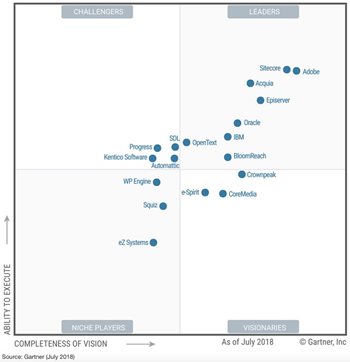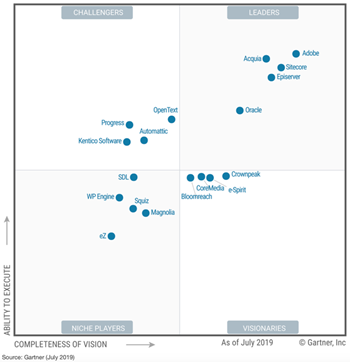2019 Gartner Magic Quadrant for WCM — Leaders & Challengers
 CMS-Connected Media Corp (CMSC Media) is pleased to present our review of the 2019 Gartner Magic Quadrant for Web Content Management (WCM). In our two-part series, we speak exclusively to twelve of the WCM vendors featured in the 2019 Gartner report to hear their perspective on Gartner’s MQ assessments and their specific magic quadrant position. As with everyone who closely follows Gartner reports, we were eager to check out the movement of blue dots across the four quadrants as compared to our previous Gartner Magic Quadrant 2018 review. At first glance, this year’s Gartner Matrix shows that there have been some migrations, one new addition, and one notable absence.
CMS-Connected Media Corp (CMSC Media) is pleased to present our review of the 2019 Gartner Magic Quadrant for Web Content Management (WCM). In our two-part series, we speak exclusively to twelve of the WCM vendors featured in the 2019 Gartner report to hear their perspective on Gartner’s MQ assessments and their specific magic quadrant position. As with everyone who closely follows Gartner reports, we were eager to check out the movement of blue dots across the four quadrants as compared to our previous Gartner Magic Quadrant 2018 review. At first glance, this year’s Gartner Matrix shows that there have been some migrations, one new addition, and one notable absence.
In CMSC Media’s Part One assessment of this year’s Gartner’s Magic Quadrant report, we discuss the Leaders and Challengers and proudly share our exclusive interviews with seven of the vendors represented in these respective categories.In our Part Two analysis, we review vendors from the Visionary and Niche Players quadrants.
Click our link to receive a free copy of the 2019 Gartner Magic Quadrant for Web Content Management
According to Gartner, Web Content Management is the “process of creating, managing, and delivering content over one or more digital channels through the use of specific management solutions based on a core repository.” Gartner also considers the following as essential functionalities when evaluating WCM solutions:
• Content creating functions
• Repositories that organize and provide content metadata
• Library services
• Website management functions
• Content deployment functions
• Personalization and analytics capabilities
• Integration abilities
• Hybrid and pure headless capabilities for API-driven omnichannel content delivery
Gartner ranks the vendors and assigns them into four different quadrants as follows:
Leaders — Gartner classifies vendors that drive market transformation as leaders. They innovate and execute out their visions. They have well-established partnerships, broad regional presence, sound financial performance, excellent platform and customer support, and expertise in one or more vertical markets.
Challengers — While delivering on performance, the challengers lack the vision Gartner likes to see. They can have a solid WCM product but fail to focus on other factors such as strategy, user context, multichannel output, and interoperability with adjacent technologies.
Visionaries — As the name implies, this group has vision. They innovate and develop on core aspects of their offering and have the ability to set market trends, but the execution is not their forte.
Niche Players — Those in this category tend to be focused on specific segments of the market, which, while it has its benefits can mean growth and expansion might be hard.
| 2018 Gartner Magic Quadrant for WCM |
2019 Gartner Magic Quadrant for WCM |
 |
 |
| Click images above to enlarge |
Leaders (Adobe, Acquia, Sitecore, Episerver, and Oracle)
Acquia
Acquia continues to hold on to its leading position thanks to its deep understanding of the WCM Market, solid product vision and roadmap, and Drupal capabilities. However, the report deems their Drupal cloud-hosting and a confusing price structure as areas that need improvement.
 Interviewee: Tom Wentworth, SVP of Product Marketing at Acquia
Interviewee: Tom Wentworth, SVP of Product Marketing at Acquia
You were named as one of the leaders in this year's Gartner MQ for Web Content Management. What do you think got you that spot?
"When Gartner wrote the first Web Content Management Magic Quadrant in 2009, open-source was still perceived as risky and almost all WCM was deployed on-premise. Now ten years later, open source dominates enterprise IT, and nearly all applications are delivered in the cloud. Acquia pioneered open-source WCM in the cloud, and our strong position in the MQ is a reflection of those early bets we made."
What sets Acquia apart from other WCM vendors in the Quadrant?
"Open source platforms like Drupal changed the rules of Web Content Management. You used to have to wait months or years until vendors delivered the new features that you needed, but with Drupal, you can grab whatever you need from the community, or build something yourself. You used to have to be an expert in the vendor-specific front ends; now you can use React, Angular, or whatever you want.
This means that Acquia customers can innovate faster at a lower cost than the rigid, dated proprietary vendors in the MQ."
Do you agree with the Gartner assessments? If so, how does Acquia plan on improving on the
'cautions'?
"Gartner talks to dozens of our customers each year, so we take any feedback from Gartner very seriously. Back in the early days of the MQ, Gartner told us that we needed to add more capabilities for marketers and that we needed to invest in our partner channel. And they were right.
We always make it a priority to address any negative feedback, and we’ll do so this year."
What is on the horizon for Acquia's WCM offerings?
"Acquia has a proven track record of advancing the WCM market forward. We were the first vendor to bring open-source and cloud delivery into web content management.
We think that Digital Experience Platforms are the future of Web Content Management, as websites become just another touchpoint in the cross-channel customer journey. Our recent acquisition of Mautic is an example of our commitment to expanding our DXP capabilities.
But there’s still lots more to do in Web Content Management. We’re working on something for next year that we think will be another step-change forward, just like we’ve done with open source and cloud. Stay tuned :)"
Adobe
The Adobe Experience Manager (AEM) remains in the top position and continues to be seen as one of the highest regarded vendors in WCM. Adobe’s newest acquisitions of Magento and Marketo, as well as continual developments on projects such as the Adobe Sensei, signals the vendor is going full steam ahead when it comes to growth and innovation. Adobe's pricing, the complexity of its services, offers, and implementation can be prohibitive for clients with limited resources. Unfortuntately, CMSC Media was unable to schedule an interview with Adobe in time for our article publication.
Episerver
Episerver is still a leader thanks to its product portfolio for content management, digital marketing, and digital commerce as well as usability and experience management capabilities. Episerver’s clients appreciate its clear pricing strategy but don't seem to be particularly happy with its sales and service support. Gartner recommends the vendor work on enhancing brand awareness and presence as well as their partner ecosystem.
 Interviewee: Nate Barad, Product Marketing & Strategy at Episerver
Interviewee: Nate Barad, Product Marketing & Strategy at Episerver
You were named as one of the leaders in this year's Gartner MQ for Web Content Management. What do you think got you that spot?
"The loudest thing we do is ship software, which we are constantly doing with updates and new features weekly. Customer appreciation also speaks loudly, and we are proud of the positive support and feedback our customers share with us as they are using Episerver to merge digital and human experiences."
What sets Episerver apart from other WCM vendors in the Quadrant?
"Our customers consistently appreciate the agility of our products and the support from our teams. The products deliver value immediately and are agile enough for small and large projects. We appreciate the reality that many organizations face with staff and resources, while we all still desire for a stellar experience for our customers and theirs. New digital engagements are launched quickly, in a realistic time frame and budget, which delivers valuable wins to business and end-users."
What is on the horizon for Episerver's WCM offerings?
"Customers are treated to incremental improvements every week, with a range of security and performance improvements combined with new features. Our short-term launches have delivered improved support for additional channels such as Progressive Web Applications and Single Page Applications. A blend of analytics and optimization will continue delivering the most relevant content to each visitor, while also enabling a variety of new channels for customers to consume content and interact with businesses. In the longer term, our continued research into automation will deliver more value to marketers and business teams. A mix of data-driven recommendations, with the creative abilities of content authors and designers, will provide more ease to the experience of creating and personalizing content. We will continue to help teams engage customers on new channels, with less friction and more success."
Do you agree with the Gartner assessments? If so, How does Episerver plan on improving on the 'cautions'?
"Episerver has worked diligently to offer outstanding software and usability at practical packages. It is incredibly rewarding to read that Gartner recognizes how much customers appreciate the applicability of our products and packages. The architecture our product teams maintain, and the continuous rate of improvement is the best in the market, and that enables our customers to increase success, streamline processes and spend more time on delighting their customers. We are regularly evaluating ourselves for improvement and working with our customers for feedback and requests. Our partner program is in an excellent spot in our maturity where there are established experts across a range of verticals and regions, while we are also investing in self-service training, education, and increased certifications to better the choices a customer has in working with us and our partners."
Oracle
The constant innovations and enhanced capabilities of Oracle keep the vendor firmly positioned in the leader quadrant for yet another year. The Oracle Content and Experience (OCM), described by Gartner as an "architecturally powerful rethinking of WCM in the context of the customer experience" is listed as both a strength as well as a caution, depending on the buyer and its needs.
 Interviewee: Chris Stone, Senior Vice President of Product Development at Oracle
Interviewee: Chris Stone, Senior Vice President of Product Development at Oracle
Gartner named you as a Leader in this year’s Web Content Management MQ. What do you think got you that spot?
"Hard work. Oracle leadership saw the value in what we were building and invested in us.
OCE (Oracle Content and Experience) is a brand new product. We have been designing it for over two years and releasing the new architecture/ features monthly for the past 15 months. It was built by a team with vast experience in Content Management systems (backgrounds in WebCenter product line, Document management, machine learning expertise, Acquia, etc.). We built this as a Cloud Native service. It is *not* ported or lift and shifted from an On-Premise implementation. It is new and takes advantage of all the new underlying technology available today via Oracle’s Generation 2 Cloud infrastructure, Oracles Cloud Infrastructure. Our competitors build great products but will need to go through a re-tooling or re-building (we chose this path) that we just did or suffer severe technical debt reliability, performance, and integration issues. We feel we earned this spot because we were focused; we knew what the market wanted in functionality, simplicity, API first approach, Asset management, and smart authoring."
What sets you apart from other WCM vendors in the Quadrant?
"Frankly, we are not focused all that much on just WCM. Indeed we feel we're moving beyond the notion of a traditional CMS. A CMS is a CMS. We view the world as 'pageless' now, which extends us forward from traditional WCM. We are much more focused on the ingestion, editing, integration, analysis, discovery, managing and distribution of assets whether it be documents, images, videos, communities, etc. on any device, any form. Whizbang content creation features are critical to success, but they are not the holy grail that customers want. We also have the strength and advantage of the Oracle customer base, sales force, consulting, and partner programs to help bring this product to market. Everyone is an armchair product manager, and that feeds our requirements and storytelling. The most compelling advantage over competitors is what was stated previously. It’s built as a Cloud-native service. Drupal has been around 20+ years and never built to be distributed. Other competitors are not built for the future. This is an exciting new product with built-in machine learning for smart authoring and personalization. It’s all-in-one. We don’t have separate “dead scientist” projects that have to be integrated."
Do you agree with trey Gartner assessments? If so how does Oracle plan on improving on the ‘cautions’?
"We do, except for a correction on bullet point #2.
Oracle is moving its WCM customers from the on-premises WebCenter Sites (and broader WebCenter Suite) offering to the SaaS-based OCE. Although the number of cloud-only Oracle WCM customers is increasing, OCE is still maturing. Decision-makers should take this into account as they plan their move to the cloud.
We are not ‘moving” anyone. We have an extremely large and profitable install base. It is our intention to give our customers the option to stay where they are as well take advantage of OCE. We built the capability to store, manage, and distribute WebCenter products content/documents directly into OCE’s repository via our Connector framework. This allows our customer base to migrate as they fit. Either one asset at a time with a new subscription model or bulk migrate whenever they want. This protects their investment, gives them a taste of using the Cloud service, and allows them to migrate as budgets allow. It’s working."
What is on the horizon for Oracle’s WCM offering?
"Content and Assets are the lifeblood of Marketing technologies. You will see much tighter alignment with Oracle CX products, Engagement, and Service Cloud, more ‘storytelling’ services, intuitive and elegant UI’s, image and video search by assets in the media, simple personalization based on profiles in our Unity product, mobile video services, shoppable content and much much more. We are set up for success."
Sitecore
It is no surprise to see Sitecore listed in the leader corner yet again given their platform's architecture, training and support programs and growing popularity with organizations across a wide range of industries. Gartner noted that Sitecore's been falling short in the customer experience and support department and has been hearing complaints over the vendor’s pricing.
 Interviewee: Matt Krebsbach, Senior Director of Product Marketing at Sitecore
Interviewee: Matt Krebsbach, Senior Director of Product Marketing at Sitecore
You were named as one of the leaders in this year's Gartner MQ for Web Content Management. What do you think got you that spot?
"We’re incredibly proud to mark ten consecutive years as a Leader in the MQ for Web Content Management. Few companies have merited inclusion in the MQ for that length of time, much less a position in the Leaders quadrant. Just consider how much the market has evolved over the years—in particular, what Gartner has previously referred to the “broadened perspectives” and “increased aspirations” for WCM. The category has made a pretty drastic shift from products that, for the most part, were capable of putting a presence on the web to products that now have to be able to deliver a consistent and individually relevant experience to each customer. I believe we’ve kept our position in the far upper right of the Magic Quadrant because, with each progressive step made in the WCM market, Sitecore has set a vision and payed it off with meaningful product advancements that deliver real value to our customers."
What sets Sitecore apart from other WCM vendors in the Quadrant?
"As WCM has become a more mission-critical, strategic part of the martech stack, it’s no surprise that there is a lot of me-tooism about building great digital experiences. But let’s consider the Gartner definition of web content management: 'the process of creating, managing, and delivering content over one or more digital channels through the use of specific management solutions based on a core repository.' There are three distinct content phases there—creation, management, and omnichannel delivery—and only Sitecore can manage that entire lifecycle. That’s an easy distinction relative to some WCM vendors who have predicated their entire business on delivering content to any device, which clearly doesn’t make for a great digital experience on its own. Of course, we’ve continued to invest heavily in omnichannel delivery capabilities. For example, Sitecore JavaScript Services enables organizations to build full-fledged headless experiences that retain all of the personalization, analytics, and optimization features of the Sitecore Experience Platform, which is totally unique among our competitors.
Go further up the food chain and personalization becomes a more prevalent topic, which typically means a lot of discussion about analytics and customer data management tools to help optimize the content that is delivered to customers—capabilities that Gartner noted among Sitecore’s strengths as far back as the 2011 WCM MQ. Here as well, Sitecore has kept a steady pace of innovation. Sitecore Cortex machine learning capabilities can automate many of the more mundane tasks that marketers deal with on a daily basis, as well as surface important insights from customer data to provide deeper insights about their customers, new segments, or potential revenue opportunities. But even customer intelligence married to omnichannel delivery doesn’t fully address the marketer’s challenge. You can’t personalize anything if you can’t give someone content that speaks to their particular need. This is why marketers are spending so much time and money producing content, which has created a crisis of scale, velocity, continuity, and agility. And this is where Sitecore stands out from our competitors. WCM is part of a connected process for content creation and delivery, fully connected to both the downstream channels where content is delivered as well as to the back-office systems (like ERP, PLM, etc.) that own some of the raw information used to build content. In this way, we enable companies to produce the modular content that serves as the foundation for personalization; deliver elevated experiences that put the right content in front of the right customer at the right time; and leverage our analytics capabilities to measure the performance a piece of content in a certain context so marketers can make better use of their resources the next time they plan new content."
Do you agree with the Gartner assessments? If so, how does Sitecore plan on improving on the 'cautions'?
"As in every Magic Quadrant, we received some critical feedback in this year’s WCM MQ. Like any healthy company, we're imperfect, but one of the things I appreciate about our culture at Sitecore is we know what we believe in and what we’re trying to accomplish, so we’re not afraid of constructive feedback that helps us grow stronger. When Gartner pointed to customer and partner support as an area where we could improve, we didn’t shy away from the commentary because, frankly, it’s been on our mind lately, too. It’s why we’ve been hard at work the past several months to improve the consistency, clarity, and completeness of our customer success and partner enablement capabilities. We’re not just papering over the cracks—this is a holistic overhaul of interrelated resources and services that help ensure our customers and partners get the most out of the Sitecore platform—and the full effect of these changes will be seen in the months ahead. That said, by any objective measure, we’ve made tremendous strides to turn the corner. For example, we’ve intensified our focus on strategic consulting services provided through Sitecore Business Optimization Strategies™, or SBOS, which gives our customers and partners access to industry-specific best practices curated from years of experience in Sitecore-powered digital experience transformations. Some of the improvements in SBOS are coming as a result of our acquisition of Hedgehog Development, whose expertise in the Sitecore implementation process is helping us speed up the customer and partner feedback loop so we can provide more value in less time and with less effort and, ultimately, build better products and solutions. We also made significant changes to our Solution Provider Partner Program, substantially increasing our commitments to partner support and enablement with more learning and training programs, technical resources, and project delivery support packages. And our new Chief Customer Officer, Beth Broderson, is spearheading a more focused customer success organization that has made big investments in our customer engagement processes that keep Sitecore committed and engaged post-sale, as well as training and development resources that help Sitecore users and developers increase their proficiency with the Sitecore platform."
What is on the horizon for Sitecore's WCM offerings?
"It’s probably a well-worn anecdote at this point, but it really is worth recollecting that, more than a decade ago, Sitecore began working toward a future where WCM systems served a greater purpose than being a “typewriter for the web.” We foresaw the “much broader era of digital experience management” that Gartner says the WCM market is transitioning into, while some of our competitors only now are jumping aboard after admitting that they fought for a long time against the idea of a digital experience platform. So we have a lead on most of the market, and we don’t intend to relinquish it. We’ve already done the work to integrate the adjacent digital marketing technologies such as customer data management, analytics, personalization, marketing automation, and machine learning that now differentiates and conveys value to a WCM system, which allows us to put our resources toward capabilities that improve time-to-market and delivering great experiences at scale and speed. At a high level, one major area of focus is the continued development of content-as-a-service capabilities that increase content flexibility and reuse, enable more experimentation, and enable marketers to showcase early-stage success so they can build organizational alignment and momentum behind digital transformation strategies. We also have an eye on more artificial intelligence and automation capabilities that improve ease-of-use, enhance productivity, and give marketers deeper insights about their customers deliver so they can provide new and unique experiences. And we’ll continue to deliver architectural developments and integrations that improve performance and reduce the cost of ownership. Sitecore Symposium is only a couple months away, and I hope our customers and partners will join us in Orlando from Nov. 4 – 7 to hear all about the latest capabilities we’re bringing to market as well as our longer-term roadmap."
Challengers (Automattic, OpenText, Progress Sitefinity, and Kentico Software)
Automattic
The competitive pricing, Wordpress.com VIP, and DevOps support and tools make Automattic good solution for midsize companies, but it still falls short in the service and support department especially when it comes to security, and other tools needed by larger enterprises. Unfortuntately, CMSC Media was unable to schedule an interview with Automattic in time for our article publication.
OpenText
The strengths of OpenText include its broad information management portfolio, security, and integration capabilities, authenticated experiences, and focus on complex B2B and B2B2C scenarios. Its move from Leader to Challenger could be because of its decline in reputation, market presence, and partner channel as well as its difficult TeamSite migrations from on-premises to cloud.
 Interviewee: Nali Giliana, Head of Strategy & Digital Experience Platform, OpenText
Interviewee: Nali Giliana, Head of Strategy & Digital Experience Platform, OpenText
Gartner named you as a Challenger in this year's Web Content Management MQ. How do you feel about getting that spot?
"OpenText™ TeamSite is a best-in-class headless content management platform. This makes TeamSite one of the top options for any brand focused on delivery of modern Omnichannel customer experiences. OpenText TeamSite, which can be used as a hybrid as well as headless Omnichannel platform, adapts well to the needs of any brand focused on telling a multichannel story. We continue to make significant investments in our technology, especially with regard to helping OpenText customers move to the cloud. During OpenText Enterprise World, the world’s largest Enterprise Information Management (EIM) conference hosted by OpenText this July in Toronto, we announced expansions to our cloud partnership with Google. Not only will all OpenText products, including TeamSite, have Cloud Editions by next spring, the OpenText Customer Experience business launched its new partner strategy at Enterprise World."
What sets OpenText apart from other WCM vendors in the Quadrant?
"OpenText TeamSite has established itself as the leader in delivering Omnichannel experiences in the following key areas:
-
Future Proof – TeamSite offers true decoupled authoring with runtime content repository, which enables content reuse and an agnostic presentation tier.
-
Scalability – TeamSite is the only platform to support hundreds of websites and applications with a single authoring environment and orchestration of code & content to thousands of web servers.
-
Artificial Intelligence – TeamSite takes a best-of-breed approach to content intelligence and tagging to enhance the content authoring experience as well as customer experiences.
-
Extensibility – TeamSite facilitates integrations, microservices, and APIs to enterprise applications and data lakes. The platform enables enterprises to leverage marketing & IT investments.
-
Omnichannel – TeamSite provides a platform for Omnichannel innovation and connected experiences.
-
Cloud Agnostic & TCO – TeamSite offers licensing and deployment options to reduce total cost of ownership."
Do you agree with the Gartner assessments? If so, how does OpenText plan on improving on the ‘cautions’?
"Gartner’s assessments were made based on information available to them at the time. Between the evaluation and the publishing of the Gartner Magic Quadrant, several things have happened, which were not yet made public during the evaluation, and which are directly related to the cautions.
Market Perception
OpenText signed some of the biggest companies in the world. These companies completed deep evaluations of TeamSite and our competitors’ products, and they decided to choose TeamSite. OpenText TeamSite is perfectly designed for the demanding needs of today’s digitally-savvy companies.
Cloud
This aspect is interesting as many TeamSite customers have successfully migrated to the cloud. As TeamSite is easily containerized with Docker, it’s meant to be easy to migrate to any cloud. Also, TeamSite is flexible enough to allow for a hybrid of on-premise and cloud to meet customers’ needs. At Enterprise World 2019, OpenText announced a new, expanded partnership with Google Cloud Platform (GCP) which will accelerate TeamSite capabilities and bring new managed services offerings on this hyperscale platform. We also announced at Enterprise World that all OpenText products will launch Cloud Editions (CE) in April 2020. This will ensure TeamSite is even easier to migrate to the cloud.
Partnerships
Along with the Google Cloud Platform partnership, OpenText announced at Enterprise World in July a new approach to working with partners that will strengthen the network and ensure customers receive the right support. Additionally, with the introduction of the Customer Value Organization which I am humbled to lead, we are identifying and building relationships with the right key partners; we will continue to see the partner network expand in the right way."
What is on the horizon for OpenText 's WCM offerings?
"OpenText will continue to lead in the WCM space. Customers will benefit from artificial intelligence to improve operations, customer experience, and personalization at scale. This already started in our most recent release, TeamSite 16.6, which includes AI and machine learning in features like auto-tagging for images, content suggestions, and intelligent content summaries. We are continually improving usability of OpenText TeamSite for business users as part of our customer experience platform and expanding already strong capabilities around containerization for the cloud and integrations with other OpenText platform components and third-party systems."
Progress Sitefinity
Progress Sitefinity continues to be a challenger this year thanks to its ease of development and usability, expertise in development and data connectivity tools and ability to simplify otherwise complicated capabilities. The vendor is slow when it comes to cloud adoption, lack of brand awareness and recognition and tends to have a high-level positioning when it comes to WCM requirements.
 Interviewee: Dion Picco, VP of Product Management, Product Marketing, and UX at Progress Sitefinity
Interviewee: Dion Picco, VP of Product Management, Product Marketing, and UX at Progress Sitefinity
Gartner named you as a Challenger in this year's Web Content Management MQ. How do you feel about getting that spot?
"It’s easy to get carried away with vendor placement and ignore the value of the analysis. Gartner states that organizations should align their needs with the capabilities of the vendor. Their analysis was spot on in recognizing Sitefinity’s ease of use, ability to simplify complex capabilities such as personalization, multisite deployments, integrations, and analytics. This makes Sitefinity an excellent fit for organizations not looking for a costly, complex, over-engineered WCM that will require months and months of effort led by expensive consultants."
What sets Progress apart from other WCM vendors in the Quadrant?
"It all comes down to simplicity and ease of use for all constituents involved in the process. Content authors have access to analytics that guides their activities with a highly intuitive interface to manage content. Digital marketers are able to deliver personalized, multi-channel experiences while managing conversion rates without constant help from developers. And developers and administrators can easily extend, integrate, and secure the experiences using standard technologies along with an API-first, headless architecture."
Do you agree with the Gartner assessments? If so, how does Progress plan on improving on the 'cautions'?
"Gartner recognized Progress’ overall ability to support digital experiences that are broader than a traditional WCM. At the same time, Gartner notes this as a potential positioning caution when we engage with organizations that think in a narrow, more traditional WCM capacity. While not every organization is ready to act, our prospects are very receptive to a DXP vision that leverages data and analytics effectively, integrates with any data source on-premise or in the cloud so they can support customer engagement, process automation use cases and more.
While Gartner notes that our WCM hosted cloud offering is new, Progress is completely confident in our ability to manage Sitefinity in the cloud based on extensive cloud hosting and deployment experience across our broad Progress portfolio.
Garter cautions that Sitefinity brand awareness lacks that of other vendors, but it’s important to note that Sitefinity is a two-time Gartner Peer Insights customer choice award winner for WCM."
What is on the horizon for Progress's WCM offerings?
"Our future plans are being managed across three key themes and aligned with our company strengths:
-
Continued excellence in delivering compelling digital experiences for customers, partners, and employees.
-
The ability to make data, analytics, and compute using cloud-first thinking more accessible while facilitating organizational collaboration.
-
Using AI and ML to effectively create, curate, convert, provide insight and optimization required for delightful customer experiences at scale."
Kentico Software
Kentico Software's strengths include its Enterprise Marketing Solution (EMS) flagship product which offers "native, built-in digital experience management functionality," with many customers also feeling it provides high value for money. Gartner classifies the vendor's dual product strategy, ‘all in one’ approach and increased reliance on partner implementation as ‘cautions’ and keeps Kentico in the Challenger corner for another year.
 Interviewee: Petr Palas, CEO at Kentico Software
Interviewee: Petr Palas, CEO at Kentico Software
Gartner named you as a Challenger in this year's Web Content Management MQ. How do you feel about getting that spot?
"We've been awarded the Challenger position in the Web Content Management MQ for the fourth consecutive year. We're happy about the result. Of course, just like every other vendor, we always strive to move up and to the right."
What sets Kentico apart from other WCM vendors in the Quadrant?
"We're the only vendor in this MQ that provides customers with a choice. We offer Kentico EMS, a traditional Digital Experience Platform, for customers who look for a fully integrated Content Management, Commerce, and Digital Marketing.
And then we have Kentico Cloud, a Content as a Service solution for customers who want to make content part of their microservices architecture. Kentico Cloud helps them gain control over an entire content lifecycle in a single unified environment and connects the content to other parts of their Digital Experience Stack.
Unlike other vendors, we didn't get stuck in the monolithic, web-first architecture, and we continue to bring innovative solutions."
Do you agree with the Gartner assessments? If so, how does Kentico plan on improving on the 'cautions'?
"We understand that our current communication for the two products may look confusing, and we will soon introduce a new brand for Kentico Cloud. We need to articulate better how organizations benefit from unifying their content in a modern cloud-based solution. We work with numerous enterprise organizations that struggle to manage their content in multiple legacy CMSs. That's a real problem, and we bring a solution that has been proven by companies around the world."
What is on the horizon for Kentico's WCM offerings?
"With Kentico EMS, we continue providing an easy-to-use Digital Experience Platform for the midmarket. That's our sweet spot as our competitors left that segment, and there aren't many viable offerings. We're working on a major release that will focus on providing a well-rounded DXP based on the latest technologies, including Microsoft .NET Core.
With Kentico Cloud, we focus on providing the best experience for business users who manage content in enterprise organizations. As of today, we enable collaboration across the entire content lifecycle — from planning, through content production, to headless delivery, optimization, personalization, and performance analytics. We integrate with systems organizations already have in place. The next step is to go deep and enable even more complex enterprise scenarios while keeping the authoring environment clutter-free. And we will leverage AI to provide brands with insights into the quality, consistency, and performance of their content."
Ending notes
The most notable absence from this year’s quadrant is IBM, which was dropped due to its WCM being owned by HCL technologies. The Leader quadrant is markedly less crowded than previous years with the most influential Leaders firmly holding on to their positions.
Join CMSC Media for our Part Two exploration of the 2019 Gartner Magic Quadrant for WCM tomorrow, Friday, September 6th, 2019, where we share our interviews with vendors from the Visionaries and Niche Players quadrants.
Click our link to receive a free copy of the 2019 Gartner Magic Quadrant for Web Content Management
Copyright notices and disclaimers
The contents of this review are protected by international copyright laws, database rights, and other intellectual property rights. The owner of these rights is CMS-Connected Media Corp. All product and company names and logos contained within or appearing on this review are the trademarks, service marks, or trading names of their respective owners. This document may not be copied, reproduced, distributed, or transmitted in any form or by any means without the prior permission of CMS-Connected Media Corp. While reasonable efforts have been made to ensure that the information and content of this review were correct at the date of first publication, neither CMS-Connected Media Corp., nor any person engaged or employed by CMS-Connected Media Corp., accepts any liability for any errors, omissions, or other inaccuracies. Readers should independently verify any facts and figures as no liability can be accepted in this regard — readers assume full responsibility and risk accordingly for their use of such information and content. Any views and opinions expressed in this review by individual authors or contributors are their personal views.

Ellie Somfelean
Ellie is a Reporter and Content Marketer with CMSC Media. She is passionate about social media and digital marketing. She has a vast experience with content creation, influencer marketing and brand promotion.